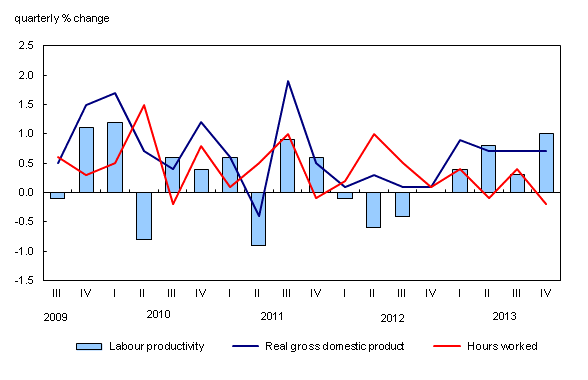Labour productivity, hourly compensation and unit labour cost, fourth quarter 2013
Archived Content
Information identified as archived is provided for reference, research or recordkeeping purposes. It is not subject to the Government of Canada Web Standards and has not been altered or updated since it was archived. Please "contact us" to request a format other than those available.
Released: 2014-03-07
Labour productivity in Canadian businesses rose 1.0% in the fourth quarter, following a 0.3% gain in the third quarter. This was the fourth consecutive quarterly increase for 2013 and the highest growth rate since the first quarter of 2010 (+1.2%).
The real gross domestic product (GDP) of businesses grew 0.7% in the fourth quarter, echoing the results observed in the previous two quarters. Output was up in almost every major industry group in the business sector. For a second consecutive quarter, the output growth of goods-producing businesses was comparable to that of service-producing businesses.
At the same time, hours worked in the business sector fell 0.2% in the fourth quarter, after increasing 0.4% in the third quarter. Goods-producing businesses, particularly construction, were largely responsible for this decrease in hours worked, which contrasts with the situation in the previous quarter. Hours worked in service-producing businesses edged up 0.1% for a second consecutive quarter.
Both goods-producing businesses and service-producing businesses contributed to the overall productivity gain in the fourth quarter.
Productivity in goods-producing businesses increased 1.7% in the fourth quarter, after falling 0.3% in the previous quarter. Construction (+2.0%) contributed the most to the increase, while productivity also grew in utilities (+3.0%) and manufacturing (+0.6%).
Productivity in service-producing businesses rose 0.5%, a fifth straight quarterly advance. Arts and entertainment (+7.2%), finance and insurance (+0.9%), administrative services (+1.6%) and wholesale trade (+0.7%) were mainly responsible for this growth.
In comparison, the productivity of American businesses increased 0.7% in the fourth quarter, a gain similar to the one observed in the third quarter.
In Canadian businesses, labour costs per unit of production were up 0.4% in the fourth quarter, as the increase in average compensation per hour worked (+1.4%) outpaced productivity growth.
However, in American dollars, the unit labour costs of Canadian businesses fell 0.6%, a fourth consecutive quarterly decline. The average value of the Canadian dollar relative to the US dollar decreased 1.0% during the quarter, marking a fourth consecutive quarter of 1.0% depreciation or more.
By comparison, the unit labour costs of American businesses declined 0.3%, after falling 0.5% in the third quarter.
Annual 2013
Labour productivity in Canadian businesses rose 1.0% in 2013, after remaining flat in 2012. In comparison, productivity growth in American businesses was also up 1.0% in 2013.
Canadian businesses increased their real output (+2.1%) at a slightly faster pace in 2013 than in 2012, while hours worked (+1.1%) continued to rise, albeit at a slower pace than in each of the three previous years.
In 2012, the real GDP of businesses (+1.7%) and hours worked (+1.8%) both grew at a comparable rate.
For 2013 as a whole, productivity increased in both goods-producing businesses (+0.5%) and service-producing businesses (+1.2%). With the exception of construction, manufacturing, wholesale trade and real estate services, productivity was up in every industry group in the business sector in 2013.
With hourly compensation (+2.4%) rising at a faster pace than productivity in 2013, the unit labour costs of Canadian businesses increased 1.3% in 2013 compared with a 3.0% gain in 2012.
However, the Canadian dollar was down an average of 3.0% in relation to the US dollar. Consequently, in American dollars, the unit labour costs of Canadian businesses fell 1.7% in 2013. In comparison, the unit labour costs of American businesses increased 0.8% in 2013.
Note to readers
Revisions
With this release on labour productivity and related measures, data were revised back to the first quarter of 2013 at the aggregate and industry levels.
Productivity measure
The term "productivity" in this release refers to labour productivity. For the purposes of this analysis, labour productivity and related variables cover the business sector only.
Labour productivity is a measure of real gross domestic product (GDP) per hour worked.
Unit labour cost is defined as the cost of workers' wages and benefits per unit of real GDP.
All the growth rates reported in this release are rounded to one decimal place. They are calculated with index numbers rounded to three decimal places, which are now available on CANSIM.
The System of macroeconomic accounts module, accessible from the Browse by key resource module of our website, features an up-to-date portrait of national and provincial economies and their structure.
Links to other releases from the national accounts can be found in the fourth quarter 2013 issue of Canadian Economic Accounts Quarterly Review, Vol. 12, no. 4 (Catalogue number13-010-X). This publication will be updated on March 14, at the time of the release of the financial flow accounts and national balance sheet accounts.
Labour productivity, hourly compensation and unit labour cost data for the first quarter will be released on June 6.
Contact information
For more information, or to enquire about the concepts, methods or data quality of this release, contact us (toll-free 1-800-263-1136; 514-283-8300; infostats@statcan.gc.ca) or Media Relations (613-951-4636; statcan.mediahotline-ligneinfomedias.statcan@canada.ca).
- Date modified:


